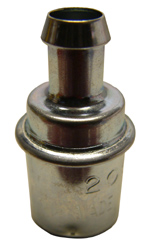PCV Valve Replacement
Description: The crankcase ventilation system, often called positive crankcase ventilation (PCV), consists of a PCV valve or metered orifice (calibrated opening), its vacuum hose or line, a supply hose providing air into the crankcase, and on some applications, a breather filter to clean the air provided to the supply hose.
 Purpose: The purpose of the PCV valve is to regulate the flow of crankcase fumes into the intake manifold where they can be burned. Prior to 1963, cars had no PCV and used road draft tubes that just left the hydrocarbon emissions from the crankcase out into the open air. The PCV valve also has a secondary role as a check valve, to prevent flow back into the crankcase. This prevents potential ignition of the crankcase fumes, should the engine backfire. The PCV system is also crucial for to proper engine sealing. The system alleviates crankcase pressure, which can push out on seals and gaskets, contributing to oil leaks.
Purpose: The purpose of the PCV valve is to regulate the flow of crankcase fumes into the intake manifold where they can be burned. Prior to 1963, cars had no PCV and used road draft tubes that just left the hydrocarbon emissions from the crankcase out into the open air. The PCV valve also has a secondary role as a check valve, to prevent flow back into the crankcase. This prevents potential ignition of the crankcase fumes, should the engine backfire. The PCV system is also crucial for to proper engine sealing. The system alleviates crankcase pressure, which can push out on seals and gaskets, contributing to oil leaks.
Maintenance Tips/Suggestions: Often times, the PCV system gets completely overlooked during routine maintenance. This is unfortunate, because PCV faults often mimic problems in other areas. Check your owner’s manual for PCV maintenance intervals and replace the valve as recommended. It should be replaced as often as every year or 15,000 miles. Oil leaks are one clue of a faulty PCV system. Leaking valve cover gaskets and rear main seals are but a few examples. If the PCV system isn’t operating correctly, crankcase pressure can build and force oil past gaskets and seals that would have otherwise been OK. Drivability problems can also result from the PCV system. Hesitation and surging can occur if the wrong valve is used or there’s a leak in the PCV vacuum hose. You can perform a quick visual check of the PCV system, but it can be tough to see certain parts because of today’s crammed engine compartments. With the engine off, check the PCV hose by looking for soft spots, as well as for signs of cracking and swelling. Also make sure that the PCV valve is properly seated in its grommet. Inspect the breather filter and the area inside the air filter housing for oil. Oil in the breather filter may be a clue to gasket leaks in the crankcase or the presence of excessive blowby gases in the crankcase. If a basic visual check doesn’t offer any clues and you suspect a problem with the PCV system, take your car to a professional service technician.
